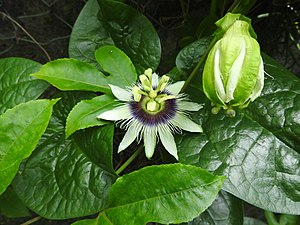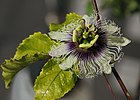Note: This is a project under development. The articles on this wiki are just being initiated and broadly incomplete. You can Help creating new pages.
Difference between revisions of "Passiflora edulis"
(→Uses) |
(→Chemical Composition) |
||
| Line 8: | Line 8: | ||
==Chemical Composition== | ==Chemical Composition== | ||
| − | + | Luteolin (1), Apigenin (2), Luteolin 6-C-glucoside (3), Apigenin 6-C-glucoside (4), Three benzenoids, Vanillic acid (5), P-hydroxybenzoic acid (6), and Syringic acid (7), One quinol, 4-acetyl-3, 5-dimethoxy-p-quinol (8) | |
<ref name="chemical composition"/> | <ref name="chemical composition"/> | ||
Revision as of 17:23, 11 June 2020
Passiflora edulis or passion fruit is a vine species of passion flower native to southern Brazil through Paraguay and northern Argentina. It is cultivated commercially in tropical and subtropical areas for its sweet, seedy fruit, commonly called passion fruit. The fruit is a pepo, a type of berry, round to oval, either yellow or dark purple at maturity, with a soft to firm, juicy interior filled with numerous seeds. The fruit is both eaten and juiced, the juice often added to other fruit juices to enhance aroma.
Contents
- 1 Uses
- 2 Parts Used
- 3 Chemical Composition
- 4 Common names
- 5 Properties
- 6 Habit
- 7 Identification
- 8 List of Ayurvedic medicine in which the herb is used
- 9 Where to get the saplings
- 10 Mode of Propagation
- 11 How to plant/cultivate
- 12 Commonly seen growing in areas
- 13 Photo Gallery
- 14 References
- 15 External Links
Uses
Anxiety,, Adjustment disorder, Attention deficit-hyperactivity disorder (ADHD), Pain, Fibromyalgia, Heart failure.
Parts Used
Chemical Composition
Luteolin (1), Apigenin (2), Luteolin 6-C-glucoside (3), Apigenin 6-C-glucoside (4), Three benzenoids, Vanillic acid (5), P-hydroxybenzoic acid (6), and Syringic acid (7), One quinol, 4-acetyl-3, 5-dimethoxy-p-quinol (8) [1]
Common names
| Language | Common name |
|---|---|
| Kannada | Gadiyaarada hoo, Jumaki hoo, Kadamba hannu |
| Hindi | |
| Malayalam | |
| Tamil | |
| Telugu | |
| Marathi | NA |
| Gujarathi | NA |
| Punjabi | NA |
| Kashmiri | NA |
| Sanskrit | |
| English | Passion Fruit, Edible Passion Flower, Passion flower, Purple granadilla |
Properties
Reference: Dravya - Substance, Rasa - Taste, Guna - Qualities, Veerya - Potency, Vipaka - Post-digesion effect, Karma - Pharmacological activity, Prabhava - Therepeutics.
Dravya
Rasa
Guna
Veerya
Vipaka
Karma
Prabhava
Habit
Identification
Leaf
| Kind | Shape | Feature |
|---|---|---|
| Simple | round in outline | perennial vine; tendrils are borne in leaf axils, and have a red or purple hue when young. |
Flower
| Type | Size | Color and composition | Stamen | More information |
|---|---|---|---|---|
| Bisexual | green sepals and 5 white petals | The flower has 5 oblong. The sepals and petals are 4-6mm in length and form a fringe. The base of the flower is a rich purple with 5 stamens, an ovary, and a branched style |
Fruit
| Type | Size | Mass | Appearance | Seeds | More information |
|---|---|---|---|---|---|
| Simple Fruit | ovoid | The fruit is 4—7.5 cm in diameter; purple fruits are smaller, weighing around 35 grams, while yellow fruits are closer to 80 grams. The smooth, leathery rind is 9–13 mm thick, including a thick layer of pith. | ark-purple with fine white specks to light yellow. | {{{6}}} |
Other features
List of Ayurvedic medicine in which the herb is used
Where to get the saplings
Mode of Propagation
How to plant/cultivate
Passion fruit is widely grown in tropical and semitropical regions of the world.In the United States, it is grown in Florida, Hawaii, and California. They generally have to be protected from frost, although certain cultivars have survived light frosts after heavy pruning of affected areas. [3]
Commonly seen growing in areas
Photo Gallery
References
External Links
- Ayurvedic Herbs known to be helpful to treat Anxiety,
- Ayurvedic Herbs known to be helpful to treat Adjustment disorder
- Ayurvedic Herbs known to be helpful to treat Attention deficit-hyperactivity disorder (ADHD)
- Ayurvedic Herbs known to be helpful to treat Pain
- Ayurvedic Herbs known to be helpful to treat Fibromyalgia
- Ayurvedic Herbs known to be helpful to treat Heart failure
- Herbs with Fruits used in medicine
- Herbs with Leaves used in medicine
- Herbs with common name in Kannada
- Herbs with common name in English
- Habit - Herbs
- Index of Plants which can be propagated by Seeds
- Herbs that are commonly seen in the region of Tropical regions
- Herbs
- Passifloraceae




